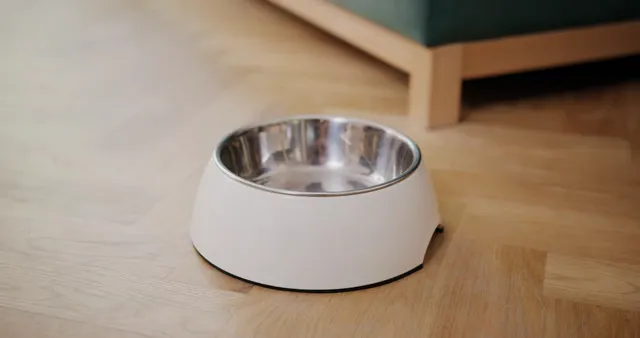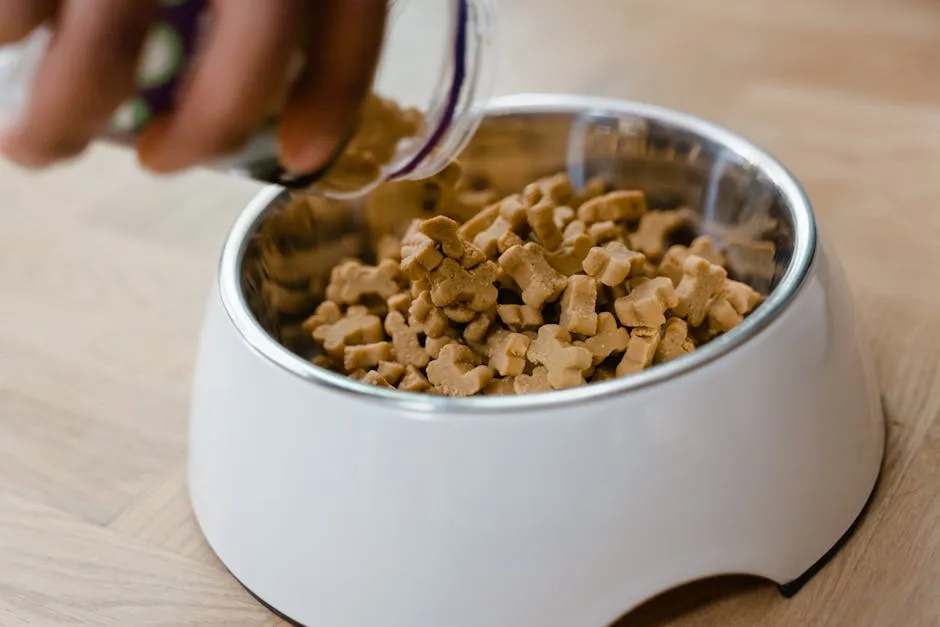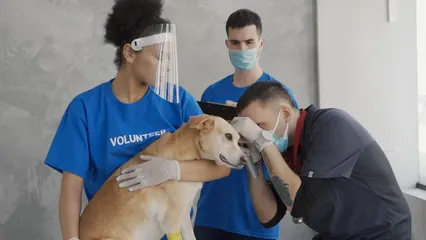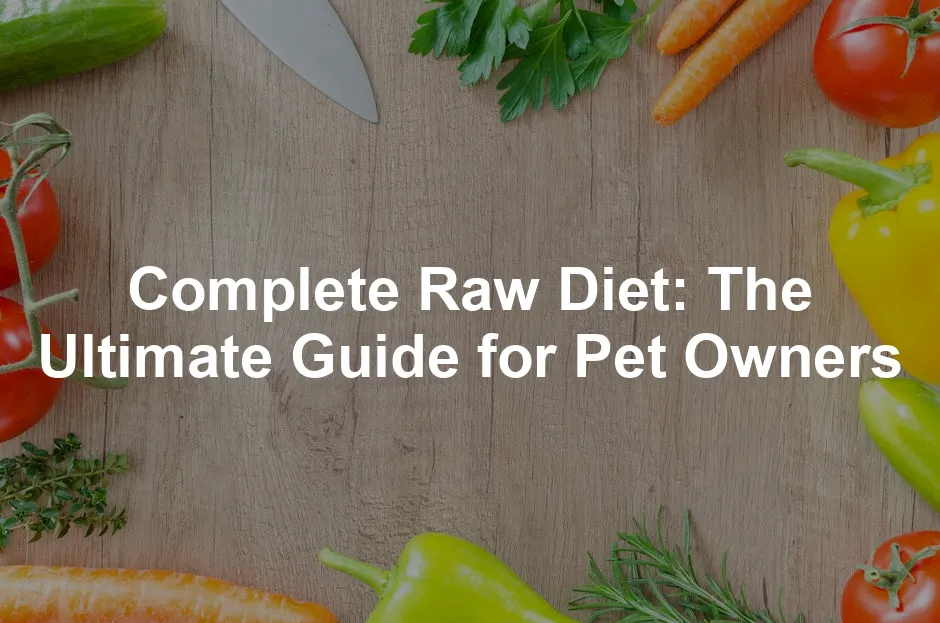Introduction
Are you considering a complete raw diet for your pet? You’re not alone! More pet owners are choosing raw diets nowadays. They believe these diets offer natural benefits that processed foods may lack. This article aims to give you all the essential information about complete raw diets. Let’s make sure you feel confident in your choices!
To help you on this journey, you might want to check out a Raw Dog Food Recipe Book. It’s packed with recipes that will make your furry friend drool and keep their diet balanced!
Summary and Overview
A complete raw diet includes raw, natural ingredients that fulfill your pet’s nutritional needs. It usually consists of muscle meat, bones, and organ meats. Feeding your pet a raw diet comes with several benefits, like improved digestion and healthier skin. However, it’s crucial to be aware of potential risks, such as nutritional imbalances and contamination. In this guide, we’ll cover everything from the basics to practical tips for implementation.
To keep those raw ingredients fresh and safe, consider investing in a Pet Food Storage Container. This can help keep your pet’s food fresh and free from pests!

Understanding Complete Raw Diets
What is a Complete Raw Diet?
A complete raw diet provides all the essential nutrients your pet needs in their daily meals. Unlike complementary diets, which may lack vital nutrients, complete raw diets adhere to strict nutritional standards set by organizations like FEDIAF and AAFCO.
A common approach is the BARF diet for dogs, which stands for Biologically Appropriate Raw Food. This diet emphasizes feeding pets ingredients that resemble what their ancestors would have eaten in the wild.
For a balanced raw diet, it’s important to maintain a proper ratio of muscle meat, bones, and organ meats. Generally, this means around 70% muscle meat, 10% raw bones, and 20% organ meats and vegetables.
Speaking of bones, consider adding some Raw Bones for Dogs to your shopping list. These are not only great for nutrition but also help with dental health!
Statistics show that about 30% of pet owners are now feeding their pets raw diets. This trend highlights the growing interest in natural pet nutrition.
When considering a raw diet, make sure to assess your pet’s unique dietary needs. Consulting a vet is a great way to ensure your pet gets balanced nutrition. Would you consider making this switch for your furry friend?

Benefits of a Complete Raw Diet
Health Advantages for Pets
Switching to a complete raw diet can benefit your furry friend in many ways. One noticeable change is an improved coat condition. Pets on raw diets often have shinier and healthier fur. This change is usually due to the high-quality proteins and fats they consume.
Another significant advantage is enhanced energy levels. Raw diets provide pets with natural nutrients, which help maintain their vigor and enthusiasm. Many pet owners report that their dogs are more playful and active after transitioning to a raw diet.
Dental health also sees a boost with a raw diet. Chewing on raw meaty bones helps clean teeth and gums. This natural dental care reduces plaque buildup and promotes healthier mouths. Better dental health can lead to fewer vet visits and less expensive treatments.
Additionally, many pets experience reduced allergies when fed a raw diet. The elimination of fillers and artificial ingredients can lessen allergic reactions. This change can help your pet feel more comfortable and improve their overall quality of life.
Want to ensure your pet stays hydrated while enjoying their meals? A Dog Water Fountain can provide fresh water all day long—no more stale bowls!
Studies support these benefits, showing that pets on raw diets often show significant health improvements. For instance, one study found that 78% of dogs on raw diets had better skin conditions and lower allergy symptoms.
Keep an eye on your pet’s health. You may notice these improvements with a complete raw diet. Monitoring their condition can help you adjust their diet as needed, ensuring they stay healthy and happy.

Key Components of a Complete Raw Diet
Nutritional Elements
A complete raw diet is essential for your pet’s health. It must contain various nutrients to ensure balanced nutrition. The primary element is protein, which should come from muscle meat and organ meat. Muscle meat provides the necessary amino acids for growth and energy.
Bones are another crucial component. They supply calcium and phosphorus, vital for strong bones and teeth. Raw bones also aid in cleaning teeth as pets chew on them.
For those who want to prepare their own meals, a Raw Meat Grinder can make meal prep a breeze. No more struggling with tough cuts!
Vegetables and fruits contribute vitamins, fiber, and antioxidants. They support digestive health and overall well-being. Including a variety of these ingredients can help meet your pet’s nutritional needs.
The importance of variety cannot be overstated. Different proteins and produce offer a broader range of nutrients. Aim for approximately 70% muscle meat, 10% raw bones, and 20% organ meat and vegetables. This ratio ensures your pet receives adequate nutrition.
Consulting with a veterinarian is wise when planning your pet’s raw diet. They can help create a personalized dietary plan that meets your pet’s unique needs, ensuring they thrive on this nutritious diet.

Preparing a Complete Raw Diet
DIY Raw Feeding
Are you ready to start preparing raw meals for your pet? Making a complete raw diet at home can be rewarding and healthier for your furry friend. Here are some steps to guide you through the process.
Ingredient Sourcing:
Begin by sourcing high-quality ingredients. Look for fresh, human-grade meats and local farms that offer organic products. Include muscle meat, organs, and raw bones. Make sure to incorporate vegetables and fruits for added nutrients. Variety is key, so rotate proteins to provide a well-rounded diet.
Meal Preparation Tips:
When prepping meals, keep it simple. Start with the BARF diet model: aim for 70% muscle meat, 10% raw bones, and 20% organs and vegetables. Chop or grind ingredients to ensure your pet can digest them easily. Prepare meals in batches and store them in the freezer for convenience. Always thaw meals in the refrigerator, not at room temperature.
Importance of Hygiene and Safe Handling:
Hygiene is crucial when handling raw food. Always wash your hands and all utensils before and after meal prep. Use separate cutting boards for raw meat and other foods to avoid cross-contamination. Store raw ingredients in sealed containers and ensure your pet’s eating area is clean.
Transitioning Pets to a Raw Diet:
Transitioning to a raw diet should be gradual. Start by mixing small amounts of raw food with their current diet. Monitor your pet for any digestive issues during this period. If all goes well, gradually increase the raw food proportion over a week or two.
Using Online Calculators for Balanced Meal Preparation:
To ensure you’re meeting your pet’s nutritional needs, consider using online calculators. These tools help you determine the right proportions of each ingredient based on your pet’s weight, age, and activity level. This way, you can create balanced meals without guesswork.
By following these guidelines, you can confidently prepare wholesome, homemade raw meals for your pet. Want to learn more about meal planning and recipes? Check out our recommended resources for detailed guidance!

Common Myths and Misconceptions
Debunking Raw Diet Myths
Many pet owners have misconceptions about raw feeding. Let’s clarify some common myths to help you make informed choices.
A common myth is that raw ingredients are difficult to digest. In reality, pets can thrive on raw diets. Their digestive systems are well-suited to handle raw food. Many owners report improved digestion after switching to raw. This includes firmer stools and less gas.
Another concern is bacterial contamination. Yes, raw meat can harbor bacteria. However, with proper hygiene, risks can be minimized. Always wash hands and surfaces after handling raw food. Using high-quality meat from reputable sources also helps reduce contamination risks.
Some believe that raw diets must include plant ingredients. While they can provide benefits, they’re not essential. Dogs primarily thrive on animal-based nutrients. Adding vegetables and fruits can enhance their diet but isn’t a requirement for health.
Educating yourself on these myths is essential. Researching raw feeding myths can open new doors for you and your pet. Consider discussing your findings with your vet for further guidance.

Potential Risks and Considerations
Understanding the Drawbacks
While raw diets can benefit pets, they also come with risks. It’s crucial to be aware of these before making the switch.
One major concern is nutritional imbalances. If not properly managed, raw diets can lack essential vitamins and minerals. This can lead to health issues over time. Pets require a balanced mix of nutrients for optimal health. Consulting a veterinarian can help create a balanced plan.
Another risk is bacterial contamination. Raw meat can carry harmful pathogens. These can pose a risk not just to pets but also to humans. Always practice safe food handling. This includes washing surfaces and utensils thoroughly after use.
Veterinary guidance is vital when considering a raw diet. Many vets recommend commercial diets that meet nutritional standards. This ensures pets receive all necessary nutrients while minimizing risks.
To help with the transition or as a backup, a Pet First Aid Kit can be a lifesaver for unexpected situations.
Statistics highlight the importance of this guidance. Reports indicate that improper raw diets have led to health issues in pets. Consulting a vet can prevent these problems and promote a healthier diet for your furry friend.
Before transitioning your pet to a raw diet, weigh these risks carefully. Seek advice from your vet to ensure a safe and balanced approach.

Conclusion
In summary, a complete raw diet offers numerous benefits for your pet’s health. We discussed how it includes fresh, natural ingredients tailored to meet their nutritional needs. Key advantages include improved coat condition, enhanced energy levels, and better dental health. However, with these benefits come responsibilities. It’s crucial to ensure a balanced diet and consult with a veterinarian for guidance. Making informed decisions about your pet’s diet can lead to a healthier and happier life. Remember, your furry friend relies on you for proper nutrition, so take the time to consider what’s best for them.

FAQs
What is the difference between a complete and complementary raw diet?
A complete raw diet contains all essential nutrients pets need. Complementary diets may lack some vital nutrients. It’s important to choose complete options for long-term health.
How do I transition my pet to a raw diet?
Start by mixing raw food with their current diet. Gradually increase the raw portion over a week or two. Monitor your pet for any digestive issues during the transition.
Are there any health risks associated with raw feeding?
Yes, potential risks include nutritional imbalances and bacterial contamination. Always consult your veterinarian before starting a raw diet to ensure safety.
Can I make my own raw dog food at home?
Yes, you can. However, ensure you follow guidelines for balanced nutrition. Consider consulting a vet or using resources to craft a complete diet.
What are the essential nutrients in a raw diet?
Key nutrients include proteins from meat, bones for calcium, and organ meats for vitamins. Vegetables and fruits also provide necessary vitamins and fiber.
Is a raw diet suitable for all dog breeds?
Most dog breeds can thrive on a raw diet, but individual needs may vary. Consult with a veterinarian for breed-specific recommendations.
How can I ensure a balanced raw diet for my pet?
Use a variety of protein sources, include bones for calcium, and add vegetables for nutrients. Regularly consult your veterinarian to adjust based on your pet’s health and activity level.
Please let us know what you think about our content by leaving a comment down below!
Thank you for reading till here 🙂
All images from Pexels





